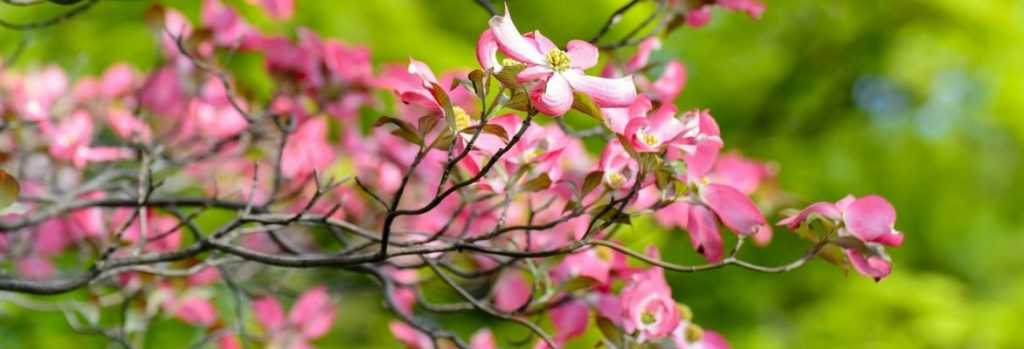
Flowering Dogwoods: Planting, Pruning and Care
Contents
Dogwoods in a nutshell
- Flowering dogwoods offer an elegant and spectacular spring bloom.
- Their large, graphic flowers consist of four prominent pink, white or yellow bracts.
- They feature decorative foliage that turns beautiful shades of brown, red or orange in autumn.
- They become covered with fleshy, highly ornamental fruits that create a striking autumn display and delight local wildlife.
- They are long-lived and thrive in partial shade, in any cool, humus-rich soil.
Our expert's word
Beauty and elegance are the perfect words to describe the enchanting charm of flowering dogwoods (Cornus in Latin).
In winter, their graceful silhouette stands out first. Then, from early spring, small green bracts surrounding an ovoid heart adorn the branches. As they bloom, the flowers grow larger, turning white or taking on colour depending on the variety. They later transform into red, strawberry-like fruits.
By August, the leaves begin to turn crimson, leading to a true autumn colour spectacle.
There are both deciduous and evergreen species. Some varieties also feature variegated foliage, brightening the garden for much of the year.
Depending on the species, flowering can span several months. The earliest are the Cornus nuttallii, whose blooms appear as early as April and last until May. Next, the Cornus florida take over from May to June, followed by the later-flowering Cornus kousa, which blooms from May to July.

The elegant flowering of Cornus kousa
Their natural elegance shines when planted as a standalone specimen, though they also work well in mixed hedges or borders.
Flowering dogwoods are easy to grow and require little maintenance once established.
Slow-growing shrubs, they need optimal conditions to thrive: a dappled position, humus-rich, moist, light soil free from lime will be key to ensuring a unique and enduring display.
Botany
Botanical data
- Latin name Cornus florida, Cornus kousa, Cornus nuttallii, Cornus rutgersensis, Cornus hongkongensis, Cornus capitata, Cornus angustata
- Family Cornaceae
- Common name flowering dogwoods, Dogwood, Florida dogwood, Chinese flowering dogwood, strawberry tree, Nuttall's dogwood, Pacific dogwood, Bentham's dogwood, Himalayan strawberry tree
- Flowering April to July
- Height 2.5 to 8 m
- Exposure partial shade, light shade, sheltered from hot sun
- Soil type acidic to neutral, humus-rich, moist and well-drained
- Hardiness -10°C for Cornus hongkongensis, capitata and angustata, -15°C for Cornus nuttallii and rutgersensis, -20°C for Cornus kousa and florida
The Cornaceae family is represented by around 40 species of Cornus (depending on botanical classifications), themselves subdivided into several subgenera including Cornus, Swida, Chamaepericlymenum, Benthamidia and hybrids. It’s the latter two that include the flowering dogwoods we’ll discuss here: Cornus kousa, florida, nuttallii, (x) rutgernensis, hongkongensis, capitata and angustata.
These woody dogwoods are native to temperate regions of the northern hemisphere (Europe, Asia or North America) where they grow naturally at forest edges or in woodland understories. They have conical or spreading habits and offer elegant silhouettes.
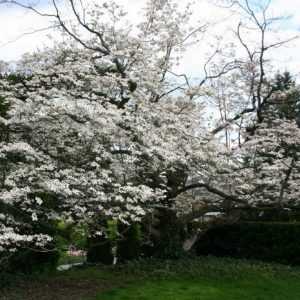
Cornus florida
Etymologically, the word cornus means “horn” in Latin, referring to the hardness of the wood. The timber from woody species was traditionally used to make tool handles, ladder rungs, spears, bows or javelins.
Flowering dogwoods form small trees or large shrubs, deciduous or evergreen, ranging from 2.5 m to 8 m in height depending on the species. Thanks to their relatively slow growth and compact size, they all adapt well to small gardens, particularly the variegated varieties which grow slowly.
They produce unscented flowers that appear from late April in mild climates for early varieties until July for late varieties. Cornus nuttallii are the first to flower in April. They are followed by Cornus florida. This early flowering makes their buds susceptible to spring frosts. Cornus kousa varieties leaf out later, making them preferable in areas prone to late frosts. Flowers appear before or with the leaves and last four to six weeks. Note that flowering dogwoods tend to produce abundant blooms every other year.
Small green “flowers” appear and grow, becoming increasingly white before developing pink hues with age. The exception is capitata whose bracts are more cream-yellow. The flowers consist of four (or more for nuttallii) large petal-like bracts arranged in an involucre around a small cluster (containing the tiny true flowers) 1-2 cm in diameter. The rounded bracts may be white, speckled raspberry, pink or yellow depending on variety. These bracts create the plant’s graceful beauty.
The simple leaves are medium green, oval, wavy and pendulous. They are borne on green young shoots that become reddish on the sunny side before the bark develops attractive grey and coppery tones depending on species. From August, the foliage of deciduous species begins to colour, culminating in spectacular autumn shades of purple-red.
Variegated Cornus florida varieties are worth planting for their beautiful foliage alone, even if flowering may be unreliable after harsh springs.
After flowering, dogwoods produce decorative compound fruits, 2-3 cm in diameter, from late summer until December if not eaten earlier. Ovoid and fleshy, turning red at maturity, the dogberries (the name given to the fruits) are much loved by birds. Some are edible but bland, others should not be consumed. Kousa fruits have sweet, pleasantly fragrant pulp but the bitter skin remains noticeable. With their strawberry-like appearance (or lychee-like), Cornus kousa fruits contain about ten seeds surrounded by pulp. The edible fruit is sometimes used to make wine.
They are all reasonably hardy in our climate, with special mention for Cornus kousa and florida which withstand temperatures around -20°C. Nuttallii and rutgersensis may struggle in colder regions, with -15°C being their limit. Finally, Cornus hongkongensis, capitata and angustata should be reserved for milder climates with minimum temperatures of -10°C.
The different species
There are nine species of flowering dogwoods. As for varieties, there are many with different growth habits, varied colours, more or less early flowering periods, diverse origins, and the vast majority are deciduous. But they all share two common traits: the beauty of spectacular flowering and a dazzling autumn colouration that leaves a lasting impression.
- The Flowering Dogwood – Cornus florida
Flowers in May/June – Mature height: 6 m
Native to North America, the Dogwood bears countless cymes in spring adorned with four large white or pink bracts. By late summer, red berries appear. Its scarlet autumn foliage is strikingly beautiful. This species is sensitive to late frosts. It requires acidic soil and high ambient humidity. It is susceptible to anthracnose, so injuries should be avoided as much as possible.

Cornus florida
- The Chinese or Japanese Dogwood – Cornus kousa
Flowers from May to July – Mature height: 4 to 5 m
Native to Japan, China, and Korea, introduced to Europe in 1875, it is more commonly planted in our gardens as it is less demanding and more compact than its American cousin. It is the latest to flower, thriving in sun (not scorching) as long as the soil doesn’t dry out. Too much shade hinders flowering. It is the easiest to grow and highly resistant to anthracnose. It adapts well to clay soils with little or no lime.
- The Pacific Dogwood – Cornus nuttallii
Flowers from April to May – Mature height: 8 m
Native to the West Coast of the United States, where it can reach 15 metres! But in our gardens, it doesn’t grow as tall. It is the earliest to flower, which means its blooms can be ruined by late frosts, common in some regions of France. The inflorescences, 10 to 12 cm in diameter, display four to seven large white bracts that turn pink with age. Autumn colours range from yellow to red. It requires decidedly acidic soil. Its lifespan is limited, especially as it lacks hardiness, but it can thrive in rainy, sheltered, and partially shaded climates. It may be affected by anthracnose.
- The Rutgers Dogwood – Cornus (x) rutgersensis
Flowers from May to July – Mature height: 4 to 6 m
This is the result of a cross between Cornus florida and Cornus kousa. It produces an abundant display of white or pink bracts. Several cultivars exist, including the magnificent ‘Stellar Pink’, as well as ‘Galaxy’ and ‘Aurora’.
- The Hong Kong Dogwood – Cornus hongkongensis
Flowers in June/July – Mature height: 4 to 6 m
It is related to the Cornus kousa. It forms a large shrub with bronze, leathery, evergreen young foliage. Its growth is rapid, but its hardiness won’t withstand temperatures below -10°C to -12°C. Easy to grow, it is not prone to diseases.
- The Himalayan Dogwood – Cornus capitata (syn. Dendropenthamia capitata)
Flowers in June/July – Mature height: 5 m
Also called Bentham’s cornel or the strawberry dogwood. As its name suggests, it is native to the Himalayas but is also found from India to China, including Nepal. This evergreen Cornus forms a handsome, rounded tree in its native habitat. Here, it rarely exceeds 5 m in height. Its large, buttery-yellow bracts offer an unusual hue for a flowering dogwood. It is best suited to mild climates where temperatures won’t drop below -10°C, in very sheltered spots and for short periods.
- The Cornus angustata
Flowers in July – Mature height: 7 m
Also called Cornus elliptica or Cornus kousa var. angustata. This medium-sized tree has evergreen, leathery foliage. Each cyme consists of four pointed white bracts, slightly smaller than those of capitata. The fruits are edible and sweet. If conditions allow, it may reflower in early autumn, with more abundant blooms in sunny spots. Hardy to -10°C.
Discover other Cornus
View all →Available in 1 sizes
Available in 1 sizes
Available in 2 sizes
Available in 1 sizes
Available in 1 sizes
Available in 2 sizes
Available in 3 sizes
Available in 2 sizes
Available in 2 sizes
Available in 1 sizes
The Different Varieties of Flowering Dogwoods
Our Favourite Varieties:

Cornus kousa subsp. chinensis Great Star - Flowering Dogwood
- Flowering time July to September
- Height at maturity 3 m

Cornus kousa Satomi - Flowering Dogwood
- Flowering time June, July
- Height at maturity 3,50 m

Cornus florida Rainbow - Flowering Dogwood
- Flowering time June, July
- Height at maturity 4,50 m

Cornus florida Rubra - Flowering Dogwood
- Flowering time June, July
- Height at maturity 6 m
Other Varieties to Discover:

Cornus florida Cherokee Daybreak - Flowering Dogwood
- Flowering time June, July
- Height at maturity 2,50 m

Cornus Venus - Flowering Dogwood
- Flowering time June, July
- Height at maturity 5 m

Cornus Ascona - Flowering Dogwood
- Flowering time May, June
- Height at maturity 5 m

Cornus kousa Milky Way - Flowering Dogwood
- Flowering time June, July
- Height at maturity 5 m
Planting Flowering Dogwoods
Where to plant?
Flowering dogwoods prefer slightly acidic to neutral, humus-rich, moist but well-drained soils.
Most Cornus species dislike intense heat and thrive in partial shade.
Plant them beneath the canopy of tall trees with open foliage, as dense overhead cover may reduce flowering. This positioning protects their leaves from scorching afternoon sun and damaging spring frosts.
However, Cornus kousa and florida can grow in full sun in oceanic and temperate climates, where they maintain an attractive shape and abundant flowering.
Smaller flowering dogwoods, particularly kousa varieties like ‘Satomi’ or ‘Great Star’, can be grown in very large containers (minimum 60cm diameter). Note: the compost must stay moist – neither waterlogged nor too dry.
Prepare a mix of: 1/3 garden soil, 1/3 compost and 1/3 pumice, peat or clay pebbles for drainage. Check regularly that the potting mix hasn’t dried out.
Position the container in a spot sheltered from cold or drying winds.
When to plant?
Plant flowering dogwoods in autumn or spring. October planting allows Cornus to establish before winter, ensuring easier growth the following spring with reduced maintenance. This also improves drought resistance. In colder regions, prefer spring planting after the risk of heavy frosts has passed.
How to plant?
To plant a flowering dogwood:
- Loosen the soil over an 80cm diameter area to 60cm depth
- Add generous amounts of leaf mould, compost or well-rotted manure, plus peat, pumice or clay pebbles to improve drainage if needed. Mix thoroughly
- Soak the rootball (in its pot) in a bucket of water until no air bubbles surface
- Dig a hole two to three times wider than the rootball to encourage root development
- Position the plant centrally, ensuring the root flare sits at soil level
- Backfill with soil, firming gently by hand
- Water thoroughly and mulch with 10cm of leaf mould or bark to retain moisture
- Water weekly during the first summer (one full watering can per plant), preferably in the evening
Flowering dogwoods aren’t fussy but require careful planting.

Maintenance
The soil should not be dry in summer or waterlogged in winter! Flowering dogwoods are sensitive to water stress. We recommend using mulch to maintain moisture and also to protect the roots from winter harshness.
Water regularly during the first year, about one watering can per week. After that, watering is unnecessary except in regions where drought is common.
For specimens grown in large pots, you can add slow-release fertiliser pellets.
Flowering dogwoods can be affected by anthracnose (or dogwood blight). Cornus florida and nuttallii are more susceptible. This is a fungal disease caused by fungi. Anthracnose appears as brownish spots edged with purple, and necrosis on leaves and twigs.
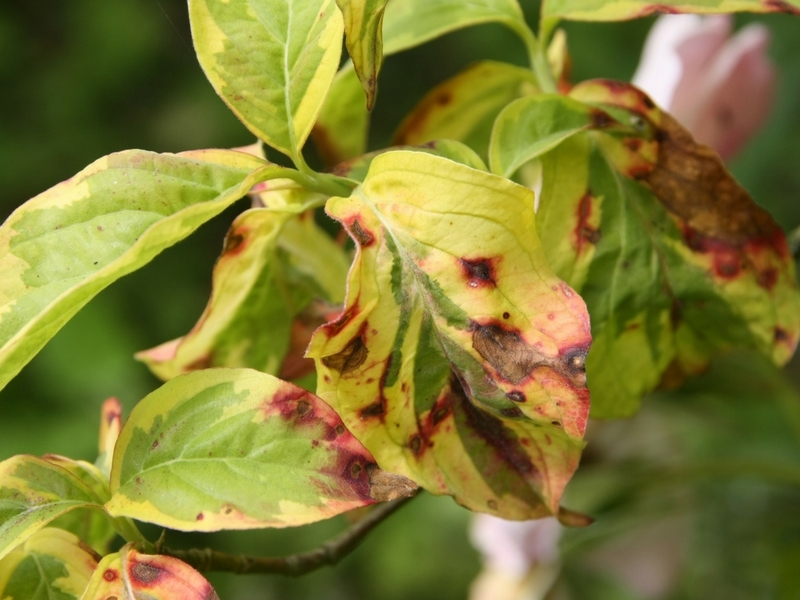
Symptoms of dogwood blight on foliage
These fungi exploit wounds to enter, so avoid pruning. Simply remove dead wood. Avoid wetting the foliage and burn any leaves showing signs of anthracnose, including fallen ones. Burn severely affected specimens to limit contamination. Choose less susceptible florida cultivars like ‘Sunset’, ‘Cherokee Princess’ or ‘Springtime’.
Powdery mildew (white mould) can also affect dogwoods. A white felting appears on leaves, which then deform and dry out. This disease may occur in humid conditions with significant day-night temperature fluctuations. Good airflow between plants helps prevent fungal infection.
Pruning Flowering Dogwoods
No pruning is necessary. Simply remove dead branches in March. You may optionally remove crossing branches or control its spread in width, though this may affect its natural silhouette.
That said, better safe than sorry: avoid pruning Cornus florida and nuttallii, as they are more susceptible to anthracnose than other species. Fungi can enter through wounds. Also, be careful not to mow too close to the lower branches!
Propagation
Propagating Flowering Dogwood is not easy. If you nevertheless wish to attempt it, you will need to proceed by sowing, cuttings or grafting.
Sowing
Sowing a Cornus requires a great deal of time and patience before you see the first blooms.
Indeed, it takes several months to observe germination and 12 to 20 years to see the first bract. If you still wish to try, you will first need to remove the harvested seeds from their pulp and sow them fresh. Then, place them in a shaded spot in the garden so they undergo what is called winter stratification. These seeds require a cold period to break dormancy and germinate.
Cuttings
Very delicate, taking cuttings is not recommended as success is highly unpredictable with flowering dogwoods.
If you wish to try, take semi-hardwood stem sections of about 15 cm in August or September.
In a shaded area where you can maintain a temperature of around 18°C, plant the cuttings in a mix of garden soil (always non-calcareous) and river sand to lighten it. When rooting is sufficient (about 2 to 3 months), carefully transplant the cuttings into pots and overwinter them in a cold frame or another location where temperatures won’t drop below 12°C. Transplanting into the garden should only occur 2 to 3 years later, with the first flowering happening many years after that.
Note that professionals use grafting (preferably shield budding) in July/August. The rootstock can be a Cornus kousa var. Chinensis, for example. Of course, grafting requires specific skills.
Association
Flowering dogwoods are at their most beautiful when planted as standalone specimens, showcasing their elegant natural silhouette and abundant blooms. However, you can perfectly plant companions at their base. They also pair well with other shrubs in informal hedges or mixed borders.
We recommend combining them with rhododendrons, azaleas, pieris and other acid-loving plants. Pairing them with evergreen shrubs that flower at different times is also a great idea, ensuring successive blooms… Consider Viburnum tinus, Camellias, Choisya ternata, Ilex, etc.
Beneath the canopy of Cornus, it’s also the perfect spot for shade-loving plants:
Useful resources
- Discover our wide range of Cornus on our website
- Advice sheet – Mulching: why and how?
- Guide on Planting perennials and shrubs
- Pascal’s article on our blog: “The Japanese Dogwood, Embodied Elegance”
- Article by Didier Willery, published in l’Ami des Jardins et de la Maison: “A Flowering Dogwood for Everyone!”
- Find our advice sheet: 10 Dogwoods for Small Gardens
- Learn more about shrubs and plants with unusual fruits in our advice sheet
Frequently asked questions
-
My strawberry tree has yellow leaves!
Dogwoods (Cornus) do not thrive in soils with excessively high pH levels or in waterlogged conditions, as they may suffer from chlorosis. The yellowing of leaves is typically caused by a nutrient deficiency, most commonly iron. You can replant your dogwood in more suitable conditions, but it's crucial to select plants based on the growing conditions you can provide in your garden.
-
Help! My Dogwood Isn't Flowering!
Don't worry, flowering may take several years to appear, especially if your Cornus is grown from seed. Also, be aware that too much shade can hinder flowering. Finally, Cornus nuttalli and florida are sensitive to spring frosts. Their flower buds form as early as February, and the blooms are often destroyed by late frosts.
-
The leaves of my Cornus are drying out! Why?
Flowering dogwoods do not tolerate scorching conditions or drying winds, and late frosts can damage their leaves and flowers. We recommend planting them in partial shade, under the canopy of taller but not too dense trees, as in light woodland settings. The exception is Cornus kousa and florida, which can tolerate sun as long as the soil remains moist.
-
The leaves of my dogwood are turning brown, what's happening?
The browning of leaves can have two causes. Either the plant is lacking water, or its roots are suffocating in soil that is too heavy and poorly drained. Simply observe the soil in that spot. If it's dry, water thoroughly and apply mulch. Repeat watering regularly, especially in summer. If it's too wet, you'll need to dig up the Cornus, trying to keep a good root ball intact. Improve drainage by adding peat, pumice or clay pebbles to a depth of 60cm. Replant your dogwood, water and mulch.
-
There are blackish spots on the leaves of my flowering dogwood! What should I do?
These are necroses, your dogwood is affected by anthracnose. Burn the parts infected by the fungus to limit contamination. Plants weakened by summer drought or injury are more prone to contracting the disease. Avoid watering the foliage and improve air circulation around the trees to help dry the leaves and contain the fungus.
- Subscribe!
- Contents




































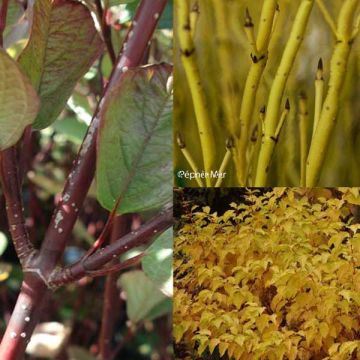
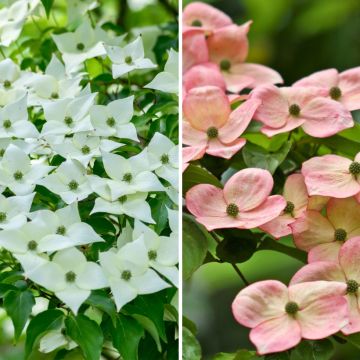
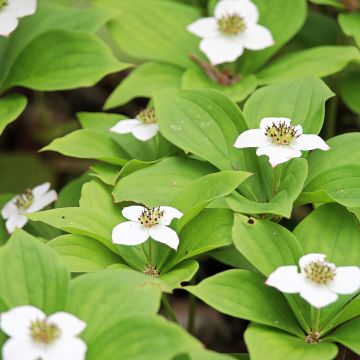
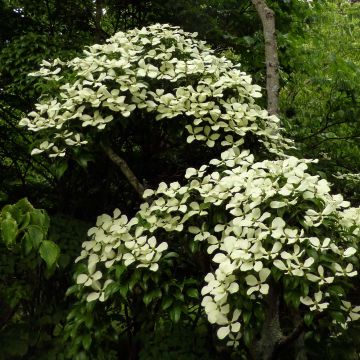

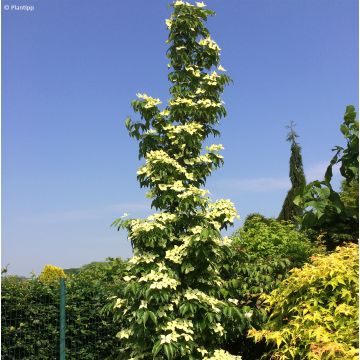
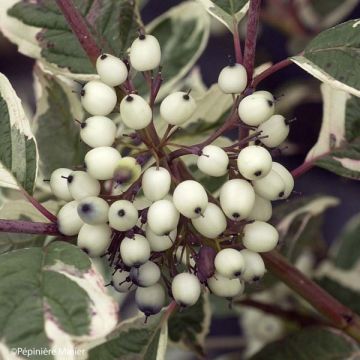
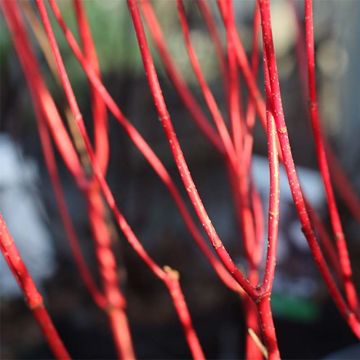
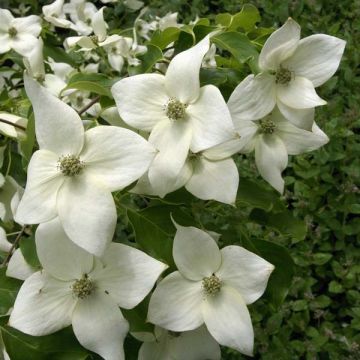
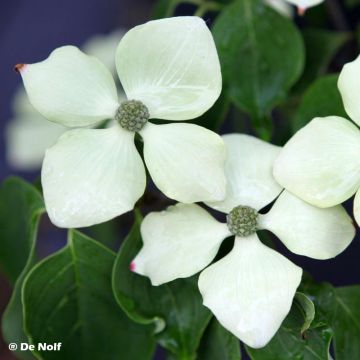


Comments